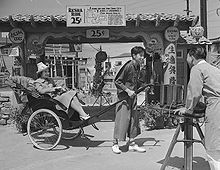
China City, Los Angeles was a short-lived "Chinatown" tourist attraction developed by Christine Sterling, who also worked on the conversion of a neglected street into the Mexican-themed Olvera Street. She conceived of a similar plan for the displaced Chinese-American population following the demolition of Old Chinatown, Los Angeles. [1]
On June 6, 1938, she opened China City, [2] [3] a walled enclave bounded by Main, Ord, Spring, and Macy (now Cesar Chavez), [4]: 37 featuring Chinese-style architecture, restaurants, shops, rickshaw rides, a lotus pond, and a temple. Costumed workers greeted tourists, and a Chinese opera troupe performed live shows in front of the shops.
Some replica buildings in China City came from the set of the 1937 Hollywood blockbuster, The Good Earth. A dragon decoration was salvaged from the Los Angeles Times building. The architect was William Tuntke, and construction was supervised by Tom Kemp, from Paramount Studios. [5] Gilbert Leong, who later was a prominent local architect, sculpted the statue of Kwan Yin that was set in a fountain for China City. [4]: 59 [6]
The China City development was described in the 1941 American Guide to Los Angeles created by the Federal Writers' Project: [7]
CHINA CITY (open 8 a.m - 2 a.m.), bounded by Ord, Main, Macy, and New High Sts, is an American-promoted, Chinese-operated amusement center designed to attract tourists. It was partly destroyed by fire early in 1939, but is now restored. The "city" stands out as an oriental oasis in the midst of Los Angeles' oldest section, which is being reclaimed in the Civic Center new-building program. The concessions grouped around a small plaza are visited in a rickshaw (25¢ per ride). Much of the construction material of the "city" was donated: pink sandstone from the old Federal Building was used for the gate, stairs, and walls, and the dedicatory stone of the entrance is from the old Times Building. Bamboo poles are from the Los Angeles Park Department, cobblestones from the Street Department.
China City received mixed support from Chinese American residents and businessmen. Many welcomed the economic opportunity the project provided. Others preferred the New Chinatown project, considered less distorted by the stereotyping lens of Hollywood. [8] During its 11-year existence, China City was destroyed by fire and rebuilt numerous times. One fire destroyed approximately 1⁄4 of China City in February 1939. [9] In 1949, an act of arson destroyed China City, and the remainder was razed in 1955. [10]
See also
References
- ^ William D. Estrada (2008). The Los Angeles Plaza: sacred and contested space. University of Texas Press. pp. 242, 244. ISBN 978-0-292-71755-8.
- ^ "Photos: China City, Recreating a Small Chinese Village". KCET. June 30, 2010. Retrieved 5 May 2020.
- ^ "New China City Celebrates First Anniversary of Birth". Los Angeles Times. June 7, 1939. Retrieved 16 June 2021.
- ^ a b Cho, Jenny; Chinese Historical Society of Southern California (2011). "Two: China City". Postcard History Series: Chinatown and China City in Los Angeles. Arcadia Publishing. pp. 37–66. ISBN 978-0-7385-8165-1. Retrieved 17 June 2021.
- ^ Ainsworth, Ed (April 3, 1938). "Along El Camino Real". Los Angeles Times. Retrieved 16 June 2021.
- ^ Historic-Cultural Monument Application for TIRADO HOUSE (PDF) (Report). Los Angeles Department of City Planning, Cultural Heritage Commission. February 6, 2013. Retrieved 16 June 2021.
- ^ Writers' Program (U.S.) (1941). Los Angeles; a guide to the city and its environs. New York: Hastings house. p. 154.
- ^ Lonsdorf, Katherine (January 4, 2011). "Lights, Camera, Chinatown". Departures. KCET. Retrieved 17 June 2021.
- ^ "China City Merchants Will Rebuild Shops Razed by Fire". Los Angeles Times. February 28, 1939. Retrieved 16 June 2021.
- ^ "Quan Yin Soon to Be All Left of Old China City". The Daily Sentinel. February 26, 1955. Retrieved 16 June 2021.